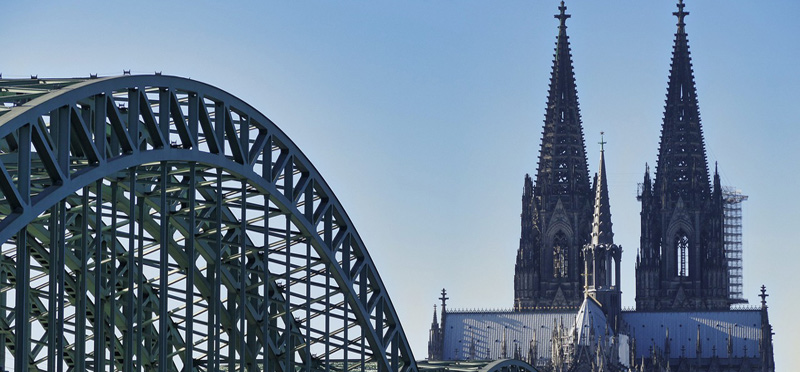BGH: KÖLNER DOM no trademark

The Cologne Cathedral is a world-famous building and has been a UNESCO World Heritage Site since 1996. Alongside the Neuschwanstein Castle, the Cologne Cathedral - in German Kölner Dom - is one of the most famous buildings in Germany.
And like Neuschwanstein, KÖLNER DOM was to be protected as a trademark. On 18 October 2018, the applicant, the Hohe Domkirche zu Köln, applied to the DPMA for registration of the sign "KÖLNER DOM" as a German word mark in various Nice classes. But in vain, the registration was refused, most recently by the Federal Patent Court (BPatG, 19 January 2023 - 25 W (pat) 526/21). The trademark applicant lodged an appeal against this decision.
The Federal Supreme Court (Bundesgerichtshof, BGH) has now ruled on this and also rejected the trademark registration of the term KÖLNER DOM due to a lack of distinctive character (BGH, 12 October 2023, I ZB 28/23, published on 12 January 2024). KÖLNER DOM cannot be protected as a German trademark.
Is this an astonishing decision when you consider that although the BGH rejected the Neuschwanstein trademark application in 2012, the ECJ ruled in its 2018 decision that trademark protection as a European Union trademark for the term Neuschwanstein was permissible (ECJ, GRUR 2018, 1146)?
Wouldn't a reorientation of the Federal Court of Justice have been expected and consideration of the ECJ's Neuschwanstein decision of 2018 for the current KÖLNER DOM decision?
KÖLNER DOM - a trademark application analogous to the Neuschwanstein trademark?
In 2018, the ECJ has ruled in its Neuschwanstein decision that the fact that goods are to be classified as souvenirs is not an argument for refusal as a trademark. Rather, as with any trademark application, the decisive factor is that the trademark gives the consumer an indication of the commercial origin without being descriptive of the goods or services claimed.
And in this respect, the ECJ had based its decision in relation to Neuschwanstein on the finding of the European Court (CFI) as the lower court that "Neuschwanstein" literally means "the new stone of the swan" and is therefore an invented and original name. With regard to the term Neuschwanstein, the ECJ found that the term was not descriptive and had distinctive character.
The BGH explained now that the situation is completely different in regard to the term KÖLNER DOM. This is because the KÖLNER DOM sign applied for consists of an adjective place name (Kölner) and a building name (Dom), which are combined in the usual linguistic manner to form a generally used term for a world-famous building, which has also been a UNIESCO World Heritage Site since 1996.
The BGH sees the partially divergent assessment of the protectability of the sign "Neuschwanstein" by the ECJ and the BGH as a logical consequence of the fact that both the BGH and the ECJ had to base their judgements on the findings of fact of the lower instance. And the European Union Intellectual Property Office (EUIPO) and the Federal Patent Court had not made the same findings with regard to the public's understanding of the meaning of the sign "Neuschwanstein".
KÖLNER DOM cannot be a trademark
The Kölner Dom is known as a cathedral, cultural monument and tourist attraction. However, this in itself is not a reason for a lack of distinctiveness.
However, the BGH did not accept the argument of the trademark applicant that relevant consumers would always infer the applicant as the owner of the Cologne cathedral when encountering goods with the designation "KÖLNER DOM". The BGH explained that the large number of souvenir shops from various providers located around the cathedral and offering goods with the Cologne Cathedral on them disproves such an understanding.
KÖLNER DOM - a BGH principle decision
In connection with the goods and services claimed by the trademark, the public would only see the imprint "KÖLNER DOM" as a motif-like reference to the well-known landmark, the Federal Patent Court had found.
The BGH confirmed this finding. Almost all of the goods claimed in the Nice classes 14, 16 and 25 are usually also used as souvenir articles, and in particular for such goods that are regularly marketed as souvenir articles, the consideration were right that it is a decorative element, but not an indication of origin.
Moreover, the Federal Patent Court had - rightly - found that the public does not recognise the designation KÖLNER DOM as an indication of commercial on goods that are not considered to be souvenirs origin either. And the appeal on points of law did not raise any separate objections to this assessment.
The appeal argued that the Federal Patent Court did not examine all possible types of use of the trademark applied for. The applicant did not intend to use the trademark applied for exclusively for the sale of souvenirs. But this argument was without success.
The BGH confirmed that the distinctiveness of a sign applied for as a trade mark must be examined taking into account all relevant facts and circumstances, including all likely uses of the trademark applied for (ECJ, GRUR 2019, 1194 - #darferdas?; BGH, GRUR 2020, 411 [juris para. 15] - #darferdas? II). All probable types of use of the trademark applied for must be examined insofar as they are of practical significance.
However, the BGH said that the ground for refusal of lack of distinctiveness pursuant to § 8 (2) No. 1 MarkenG precludes the registration of a trademark for goods and services designated by a broad generic term even if it exists with regard to individual goods and services falling under the generic term, and stipulated this as the first landmark principle of the KÖLNER DOM decision.
In the opinion of the BGH, the application sign "KÖLNER DOM" is not perceived as a commercial means of distinction even when all practically significant and therefore probable types of use in connection with the claimed goods are taken into account.
“If the public perceives the sign consisting of the name of a place of interest - consisting of an adjective place name and a building name (here: Cologne Cathedral) - in connection with goods that can be considered as travel souvenirs or supplies, only as a designation of the place of interest and not as an indication of the commercial origin of these goods, the sign lacks any distinctive character within the meaning of § 8 para. 2 No. 1 MarkenG (holding BGH, decision of 8 March 2012 - I ZB 13/11, BGHZ 193, 21 - Neuschwanstein; delimitation to ECJ, judgment of 6 September 2018 - C-488/16, GRUR 2018, 1146 - Neuschwanstein).”
The second landmark principle of the KÖLNER DOM decision, translated from German.
The decision of the Federal Patent Court was fully confirmed by the BGH and the action was dismissed (BGH decision KÖLNER DOM, I ZB 28/23). The registration of the German trademark KÖLNER DOM is not admissible.
Trademark application, trademark protection or trademark defence
Is the protection or defence of a trademark an issue for you?
Get in touch with us. The initial consultation is free of charge.
You can reach us by phone at +49 69 69 59 60-0 or please send us an email info@kollner.eu.







